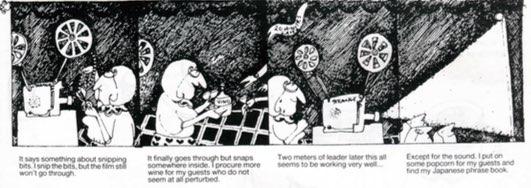Maria Eugenia Jelincic
Communications media can be used for a great many purposes: from manipulating people to follow certain models of behavior to promoting dialogue and the exchange of experiences and ideas. The dominant mass media in the world today frequently use the method of manipulation. "Alternative" communications, on the other hand, aim to motivate dialogue and participation. Communication is alternative not when it is marginal or makeshift, but when its contents, and the methods it uses to communicate, promote participation and dialogue.
In women's alternative communication, women use media to give women a voice, an opportunity to express themselves. Greater use of audiovisuals can promote this process. Audiovisuals have an explosive potential for stimulating new and wider communication. The methods used with audiovisuals, however, must be consistent with the goal of promoting greater participation. In this, discussion plays a key role. Used with the right methods, audiovisual resources can become tools which promote dialogue, stimulate participation and the expression of women's points of view, transforming women's role from spectator to active participant in the process of communication.
How To Use Audiovisuals
For the process of participation and dialogue to be fruitful, it is necessary to consider certain aspects before, during, and after the showing of the audiovisual. We would like to give a few practical suggestions about these as a contribution to women's groups who are beginning to use audiovisuals. In doing so, we have kept in mind the oftentimes difficult material conditions in which groups in the Third World are working. We will look at:
- projection equipment;
- the selection of material;
- the conditions in which the audiovisual will be shown;
- the discussion.
Projection Equipment
The article on equipment in this Guide explains about the different kinds of projection equipment. As a first step, you need to find out what kinds of equipment are available in your area. Find out in detail how these operate. If you are working in areas without electricity, find out whether you can use the equipment with a car battery or a generator.
Selecting the Material
In selecting the materials to be projected, keep in mind above all the concrete interests, needs and problems of the group. The people who are showing the audiovisual should view it beforehand so that they will be able to focus attention on the most important parts.
It is a good idea to prepare a step-by-step work plan for the group with the goals to be achieved in the process. Any audiovisuals used should be an integral part of the process. A selection of audiovisuals which can be shown throughout the work plan can be very useful. This does not necessarily mean having a large number of audiovisuals on the issue you are working on. Sometimes it is possible to take parts from audiovisuals and use them to open a discussion on the issue of concern.
The selection of materials is a creative task. It is possible to put together an endless number of variations and combinations. Some examples are:
Two short audiovisuals can be used in one meeting in order to focus on the relationship between them or to present different points of view on the issue. In this case, it is important to ensure that the length of the combined audiovisuals does not exceed the group's attention span.
Another possibility is to use parts of an audiovisual if these contain the elements needed to stimulate the group. Repeating sequences from the audiovisual during the discussion will aid in going more deeply into the issues.
The materials do not necessarily need to represent one's own point of view. With sufficient preparation, the use of audiovisuals which express opinions contrary to the interests of the group can stimulate the process of reflection. Likewise, the critical "reading" of the dominant mass media is a useful resource. It can help develop a critical spirit in regard to the messages and situations we passively consume every day. Television programs can be used, for example. Select a dramatic series (telenovelas or soap operas), variety shows, quiz programs, commercials. Even the news can be used since it reflects the marginalization of women in politics and society. If video equipment is available, it is possible to select significant parts of the transmission most useful to the work. Several exercises can be carried out with this material. One could be to take apart the mechanisms of domination in the messages and analyze them one by one.
It is also useful to prepare a packet of information materials to complement the themes under discussion. This could be distributed at the end of the meeting.
Conditions for Showing the Audiovisuals
For the audiovisuals to be most effective, certain details must be kept in mind. Although these may seem simple and obvious, they are important and not always taken into account.
The size of the room must be large enough for the number of people expected to attend. A request should be put in for the room and it should be visited beforehand in order to find out practical details, such as whether special plugs or extension cords are needed, where the projector can be placed, and what the distance will be between the projector and the screen. What lens is needed to produce an image of adequate size at this distance? What size does the screen need to be? Is it possible to project on the wall of the room if it is white, smooth and unlined? Are there enough seats for everyone? Are there pieces of furniture on which to place the projector and the speakers? What are the acoustics like? If there is a lot of echo in the room, remember that the presence of people will diminish it. Putting blankets on the wall will also lessen the echo.
On the day of projection, it is good to prepare the room and the equipment before people begin to arrive. The placement of the equipment is important for a good showing. Some suggestions for this are:
- The screen should be placed at the opposite extreme from the entrance door so that latecomers will not disturb the others.
- The projector should be placed in front of the screen in such a way that the image will not be distorted. The images must be projected high enough for everyone to see them.
- The speakers should be placed in front of the audience in the corners of the room, facing a point in the center.
- If the audiovisual being shown is a slideshow, be sure that the slides are in the correct order. If it is a film, check that it is correctly connected. Clean the lens and adjust the focus. Also adjust the sound level.
- If a video program is being used, remember that it is difficult for more than twenty people to view it on the television screen.
- Have someone present to help out with practical details; for example, putting the lights off and on.
- If it is not possible to darken the room, remember that special screens are available which permit the projection of slides in daylight. These can also be used outside for daytime showings.

The Discussion
Discussion plays a key role in the use of audiovisuals for motivating dialogue and participation. Discussion permits the participants to examine problematic aspects of issues and to search for solutions. To be effective, discussion must give the participants the opportunity to exchange ideas and experiences. Through the exercise of expressing themselves, the participants are enabled to put into practice a process of reflection and analysis, based on their own daily experiences and moving from there to more global issues.
Carried out systematically in a collective way, this can bring about a process of development on both the personal and group levels and can generate new dynamics within the organization. We would like to give a few suggestions which could be useful for facilitating group discussion:
Begin the meeting with a brief introduction, mentioning the theme and the main points of the audiovisual that is to be shown. Invite the people to participate in the discussion that will follow the showing. The facilitator can use the introduction to focus attention on those aspects of the audiovisual which can be useful for developing the discussion. The introduction can also be used to point out the limitations of an audiovisual.
The role of the facilitator is key in promoting dialogue and participation. She should not speak more than necessary, but enable others to express themselves. The facilitator should express herself simply, clearly and concisely and help others to feel confident enough to speak up. She should be familiar with the audiovisual to be shown and those parts that can be used for motivating the group. The facilitator should prepare several concrete and key questions to stimulate the discussion and to link the content of the audiovisual with the daily life of the participants.
It is important to create an atmosphere of trust. When the showing is over, the participants can be asked to form a circle. The facilitator should join the others in the circle and open the discussion with simple questions, such as: "How did you like the audiovisual?" "What struck you most about it?" Try to encourage everyone to speak. Try to avoid situations in which certain persons dominate the discussion or attitudes which could hinder the participation of some people. Draw relationships between the various points and experiences that come up in order to keep the discussion going.
Before finishing the meeting, ask for opinions about how it went and suggestions for future events. Summarize the main points of the discussion and draw out the conclusions.
These suggestions are not a recipe but a general guide which should be applied creatively depending on the actual situation in which the audiovisual is to be shown. Used in this way, they can contribute to advancing a critical perspective on reality, with a view to changing it.


